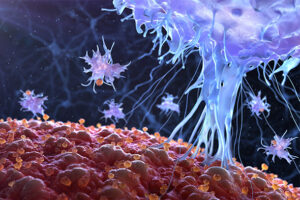Oncology
Prostate Cancer
Novel Androgen Receptor Inhibitors and New Approaches for Advanced Prostate Cancer
Overview
At different points in the disease spectrum, the novel androgen receptor (AR) inhibitors have been shown to produce clinically meaningful survival benefits for patients with prostate cancer. As next-generation AR inhibitors move earlier in the treatment paradigm, data on the side-effect profiles of these agents are expected to guide clinicians in matching an individual patient with an individual agent.
How are novel AR inhibitors being used today, and how might they be used in the future?
Michael J. Morris, MD
|
|
“The next-generation AR-directed therapies are being used ever earlier in the disease course in those with metastatic disease.”
There are several studies now, such as STAMPEDE, LATITUDE, ENZAMET, and TITAN, that demonstrate the benefits of AR-targeted therapies in the treatment of castration-sensitive prostate cancer. These studies have shown that novel AR inhibitors produce meaningful clinical benefits when introduced as initial therapy for metastatic disease. That is, survival is prolonged relative to androgen deprivation therapy alone when these therapies (ie, abiraterone plus prednisolone, enzalutamide, and apalutamide) are added to androgen deprivation therapy. Although there are some variations in the individual eligibility criteria in each study, overall, these trial data demonstrate a 30% to 40% risk reduction in mortality; so, the standard of care is to initiate treatment with AR inhibitors when metastatic prostate cancer is diagnosed, instead of waiting for castration resistance. Thus, the next-generation AR-directed therapies are being used ever earlier in the disease course in those with metastatic disease.
Further, the US Food and Drug Administration approvals of apalutamide, enzalutamide, and darolutamide in the nonmetastatic castration-resistant prostate cancer (nmCRPC) setting have led to the use of these treatments even earlier in the disease course (ie, in patients without overt metastases who are progressing despite the use of testosterone-lowering therapy). The conventional imaging component of the nmCRPC definition is noteworthy in that it reflects a limited capacity for detection. It is known that many high-risk patients staged as nmCRPC are below the threshold of disease detectability by standard imaging. With the use of more sensitive prostate-specific membrane antigen (PSMA)–based imaging, stage migration of these high-risk patients toward the metastatic disease continuum would be likely. Apalutamide, enzalutamide, and darolutamide were initially each shown to delay radiographic disease progression and improve metastasis-free survival in patients with nmCRPC. More recently, overall survival benefits have been reported as well. As all 3 agents have similar efficacy based on data from the respective clinical trials, consideration of their differing side-effect profiles becomes prominent.
Head-to-head data are not yet available; however, darolutamide has lesser blood-brain penetration, which might translate to a favorable central nervous system (CNS) side-effect profile. In an older male population, comorbid diseases such as diabetes, hypertension, and coronary artery disease are common, as are neurologic diseases such as Parkinson’s disease, depression, and dementia, so these patients may be on various CNS-active medications. Two trials comparing the effects of enzalutamide and darolutamide on exercise tolerance and cognition are in development or are opening now. I do think that the side-effect profiles of these agents can help guide a clinician toward matching an individual patient with an individual agent. Drug-drug interactions should be considered with any of these agents, given that patients with prostate cancer are frequently on numerous other therapies. In addition, abiraterone may have fewer CNS side effects than enzalutamide; however, abiraterone can be associated with electrolyte and fluid changes. Further, for the patient with poorly controlled diabetes, intolerance of steroids may be a consideration as well.
Regarding future research directions, there is much attention being paid to neoadjuvant treatment with next-generation AR axis–directed therapy, in advance of primary definitive local therapy such as surgery and radiation. Additionally, new treatment paradigms stemming from the more widespread use of advanced imaging will be important to examine.
Peter R. Carroll, MD, MPH
|
|
“Regarding the use of AR antagonists as neoadjuvant therapy prior to prostatectomy, I think that this is a great space for clinical trials.”
Regarding the use of AR antagonists as neoadjuvant therapy prior to prostatectomy, I think that this is a great space for clinical trials. Work by McKay et al illustrates the potential for neoadjuvant antiandrogen therapy followed by radical prostatectomy in high-risk patients with locally advanced prostate cancer. Additionally, we have been looking at different strategies for patients with high-risk nmCRPC (ie, PSMA-negative except for the primary), including the potential use of neoadjuvant immunotherapy, so we often consider clinical trials in our discussions with these high-risk patients. Then, after the prostatectomy, in view of the pathology report, margins, lymph node status, postoperative prostate-specific antigen, and genomic profiling, we have a good idea of where they are headed, and AR antagonists might be considered at that time.
I agree that the use of PSMA-based imaging is going to be a very important driver of changes as we look to the future. Fendler et al reported last year on the use of PSMA–positron emission tomography (PET) in a SPARTAN-like patient population, and, of the 200 patients who were examined, 196 had imageable disease by PSMA-PET. Additionally, PSMA-PET detected M1 disease in 55% of patients previously staged as nmCRPC by conventional imaging. So, clearly, many patients with nmCRPC by conventional imaging may have N+ or M+ disease by PSMA-PET.
Early in my career, I thought that prostate cancer was either localized or distant, with no intermediate step. After being in the field for many years and performing thousands of prostatectomies and following them over time, it has become clear that some patients who relapse do not have widespread metastatic disease, but have instead what might be considered discrete islands of disease. It is remarkable what we now see on PSMA-based imaging, either at diagnosis or at relapse after surgery or radiation. Based on this, many are more aggressive in the oligometastatic state, whether it is defined by lymph node involvement only or bone lesions. Further follow-up will determine whether such a strategy is cost-effective and improves outcomes (quality of life, disease-specific and overall survival).
References
Chi KN, Agarwal N, Bjartell A, et al; TITAN Investigators. Apalutamide for metastatic, castration-sensitive prostate cancer. N Engl J Med. 2019;381(1):13-24. doi:10.1056/NEJMoa1903307
ClinicalTrials.gov. Androgen receptor directed therapy on cognitive function in patients treated with darolutamide or enzalutamide (ARACOG). Accessed July 6, 2020. https://clinicaltrials.gov/ct2/show/NCT04335682
ClinicalTrials.gov. Study to compare the effects of drug darolutamide and drug enzalutamide on physical function, including balance and daily activity, in patients with castration-resistant prostate cancer (CRPC) (DaroAcT). Accessed July 6, 2020. https://clinicaltrials.gov/ct2/show/NCT04157088
Davis ID, Martin AJ, Stockler MR, et al; ENZAMET Trial Investigators and the Australian and New Zealand Urogenital and Prostate Cancer Trials Group. Enzalutamide with standard first-line therapy in metastatic prostate cancer. N Engl J Med. 2019;381(2):121-131. doi:10.1056/NEJMoa1903835
Fendler WP, Weber M, Iravani A, et al. Prostate-specific membrane antigen ligand positron emission tomography in men with nonmetastatic castration-resistant prostate cancer. Clin Cancer Res. 2019;25(24):7448-7454. doi:10.1158/1078-0432.CCR-19-1050
Fizazi K, Shore ND, Tammela T, et al. Overall survival (OS) results of phase III ARAMIS study of darolutamide (DARO) added to androgen deprivation therapy (ADT) for nonmetastatic castration-resistant prostate cancer (nmCRPC) [abstract 5514]. J Clin Oncol. 2020;38(15 suppl):5514.
doi:10.1200/JCO.2020.38.15_suppl.5514
Fizazi K, Tran N, Fein L, et al. Abiraterone acetate plus prednisone in patients with newly diagnosed high-risk metastatic castration-sensitive prostate cancer (LATITUDE): final overall survival analysis of a randomised, double-blind, phase 3 trial. Lancet Oncol. 2019;20(5):686-700. doi:10.1016/S1470-2045(19)30082-8
James ND, de Bono JS, Spears MR, et al; STAMPEDE Investigators. Abiraterone for prostate cancer not previously treated with hormone therapy. N Engl J Med. 2017;377(4):338-351. doi:10.1056/NEJMoa1702900
McKay RR, Ye H, Xie W, et al. Evaluation of intense androgen deprivation before prostatectomy: a randomized phase II trial of enzalutamide and leuprolide with or without abiraterone. J Clin Oncol. 2019;37(11):923-931. doi:10.1200/JCO.18.01777












